Story is about the Lhotse 8516 expedition
Story is about the Lhotse 8516 expedition
Today, my story is about the Lhotse expedition, about our services and why our participants pay $ 18,000 for full service and$ 36,000 for VIP service. I would like to draw your attention to the fact that the services provided and their quality strictly correspond to this description. Since the event is very large-scale, my story will be divided into 2 chapters - approaches and ascent.

Short information
Lhotse is a mountain in the Himalayas. The fourth highest eight-thousand-meter mountain in the world. It is located on the border of China and Nepal (Tibet Autonomous region) in the Mahalangur-Himal mountain range. It is part of the Sagarmatha national Park (Nepal). Mount Lhotse is located in the Mahalangur-Himal range on the border of Nepal with China, 3 km South of Chomolungma and separated from it by the South saddle pass (7906 m). From the South Col to the Summit, the elevation difference is 610 meters. Lhotse has the form of a three-sided pyramid with pronounced southern, Eastern and Western (sometimes called North-Western) walls separated by extended ridges.
The mountain was first climbed by the Swiss expedition of Ernst Reiss and Fritz Luchsinger on may 18, 1956. 14 years later, there was an ascent to the top of Lhotse Shar. All 3 of the first climb to the top was in may.

Until 2016, Lhotse has the smallest number of routes in comparison with other eight-thousandths of the planet: Lhotse Main- three, Lhotse Shar- two, and Lhotse Middle- one.
On may 20, 1984, a new route along the complex southern wall was laid on the Lhotse Shar by a Czechoslovak expedition — Peter Bojik, Jarik Stejskal and Yosef Rakontzai climbed to the top
On December 31, 1988, the first and only winter ascent of the Lhotse Main along the classic route was made by a pole Krzysztof Wielicki. Numerous attempts to climb the southern wall of the mountain in winter by the Japanise Osamy Tanabe were unsuccessful (in the winter of 2006, he did not reach the top by a few meters).
In 1990, Slovenian mountaineer Tomo Cesen announced a new route and ascent to the Main peak on the southern wall
In October 1990, the first Soviet expedition under the leadership of A. Shevchenko laid a new route along the southern wall, which Reinhold Messner called the "wall of the XXI century": "Climbing the Lhotse wall is not just an eight-thousand-meter climb, it is the culmination of mountaineering. Of course, there are and will remain other impassable walls in the Himalayas and Karakoram, but there is no equal to the southern wall of Lhotse in the world, this is the route of the 21st century." Sergey Bershov and Vladimir Karataev climbed it to the top. Earlier, repeated attempts to pass the wall were made by Polish climbers, including Jerzy Kukuczka (the second climber after R. Messner to all 14 eight-thousand-meter peaks of the Earth).
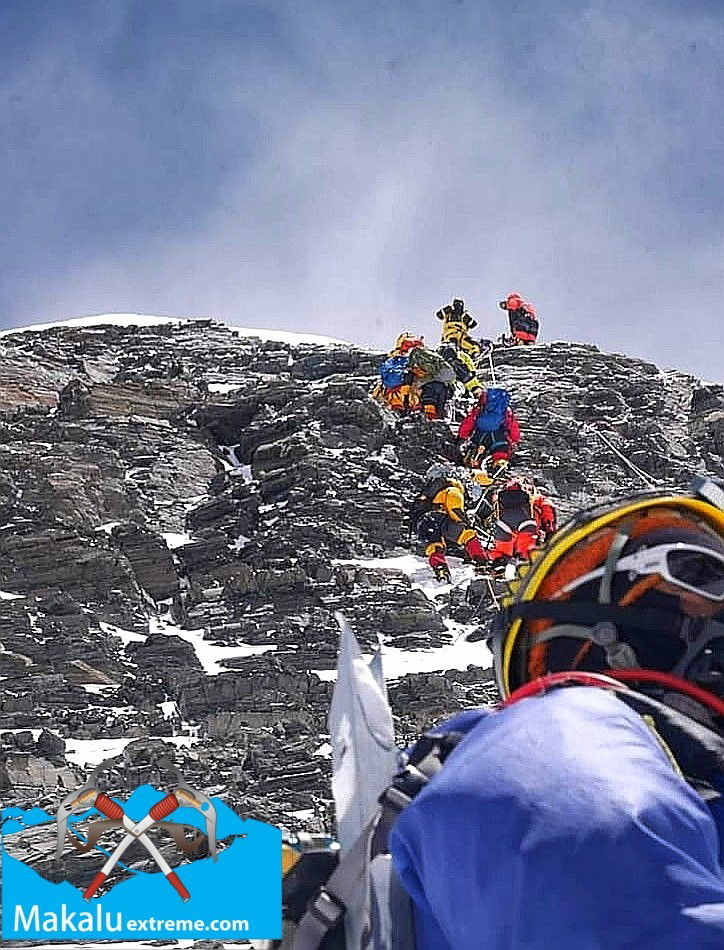
On may 10, 1996, the first French woman, Chantal Moduy, ascended the Lhotse Main.
On may 16, 2010, Denis Urubko made the first (single) ascent of the Northern ridge to the Main peak.
Until 1996, the speed record for climbing Lhotse was held by Carlos Carsolio — on may 13, 1994, he reached the summit from base camp in 23 hours and 50 minutes. On may 17, 1996, Anatoly Bukreev climbed to the top in 21 hours and 16 minutes (along the classic route). On may 14, 2011, American Michael Horst climbed mount Everest and Lhotse in 21 hours (from the South Col).– at medium.
Now we back to our expedition to the Top of Lhotse 8516
The first is why you should come with us. Everything is very simple here. You will work with Pasang Lama and Purba Sherpa as the main guides and I and Dorchi Sherpa as the organizers. Dorchy and I usually go to the Top, too. We usually use my permanent guide, Pasang Dorji Sherpa. We have our experience on our team - 19 ascents to the Top of Lhotse. Let me explain-Dorchi Sherpa (organizer)- 5 Ascents, Oksana Morneva (organizer)- 2 ascents, Dorji Sherpa( organizer's guide) - 2 ascents, Pasang Lama - 5 ascents, Purba Sherpa-5 Ascents, also climbed the southern Wall of Lhotse to the 8200 mark as part of the Korean expedition and as its leader, in the autumn seasons. As our next season is autumn, here we need experience and knowledge of this Mountain Purba in the autumn. You may conclude that you will not find a team that knows this Mountain as well as we do. And also, our mountaineering is still commercial, so we try to minimize stressful and uncomfortable situations on the Mountain for OUR participants. We hold the lives of our participants in our hands, and we are very much aware of our responsibility.

How is our tour going?
Our not virtual introduction starts at the Tribuhwan international airport. We personally-I, Dorchi or Pasang Lama meet You at the airport with the logo of our company. The transfer can be individual, or it can be a group, if suddenly
You arrive at the same time with one of the participants. It takes about 20-30 minutes to get from the airport to the tourist center of Tamel, where located our hotel. Our groups stay in a comfortable hotel decorated in the local national style. The rooms are equipped with hot and cold water, air conditioning, and water glasses. Participants of the "Full Service" program have accommodation for 2 people in a room. VIP program participants have accommodation in VIP rooms, single accommodation. The package Price includes 4 nights in a hotel.
Here, our participants try on their expedition jackets, which are issued by our company. Jackets are cool - they look very impressive and lift the mood.
The next day, very early in the morning, we go to the Seto Gompa monastery for Puja. This is one of the largest monasteries in Kathmandu with ancient traditions. Puja - a worship service for the successful ascent to the Summit. According to local traditions, any expedition not begins without this rite and the blessing of the Supreme monk. After the Puja, we return to the hotel. Participants have free time - you can buy what you may need in the Mountains.
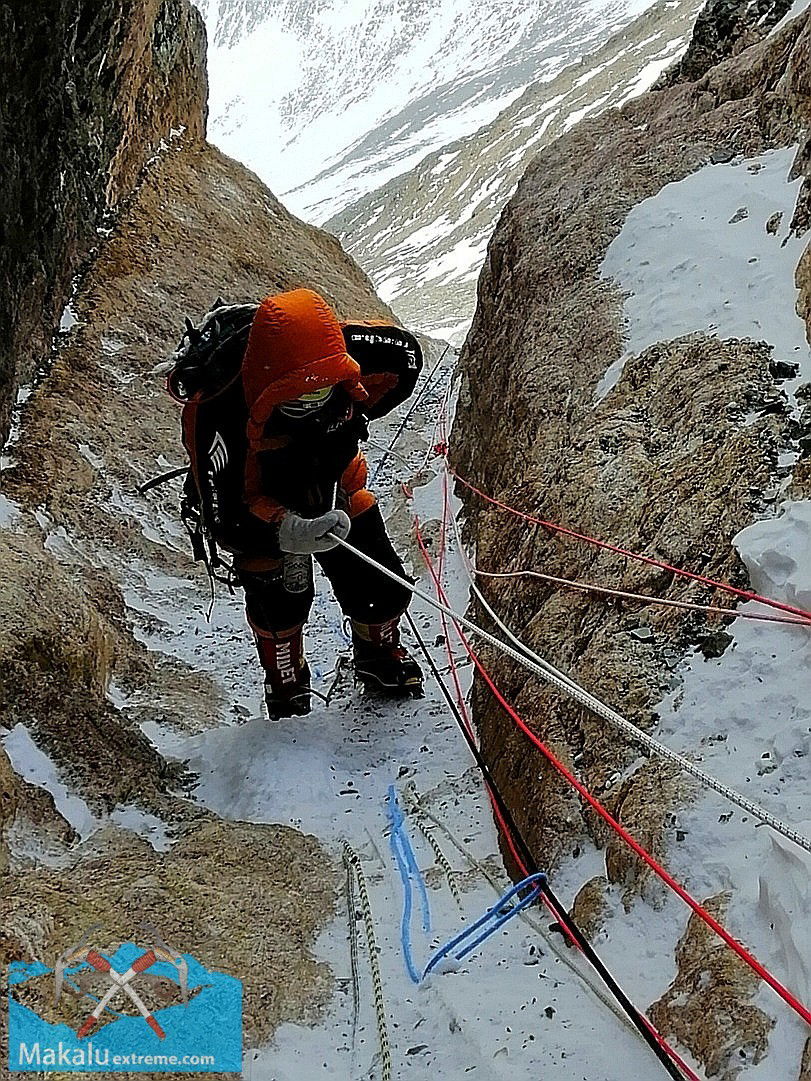
The next day we have an early check-out. We go to Paplu or Ramechap airport to fly from there to Lukla by private company transport. Only expedition participants and accompanying guides are allowed in a jeep or minibus. The decision where we will fly from is made about a month before the start of the expedition, depending on the flight schedule. But, if possible, of course , we prefer flights Phaplu - Syangboche. We will describe this standard version here. And so, at about 3 PM, We arrive in Phaplu and check in at the airport hotel. Phaplu is a village in the mountains in Solukhumbu district at an altitude of 2430 meters. Phaplu was the first airport to be built in the region. A social project called the airport in Phaplu was led by Edmund Hilary. The airport was built in October 1976.
The organizers buy fresh vegetables for the expedition, and participants can take a guided tour of the surrounding area.

The next morning we fly to Syangboche. Syangboche is located at an altitude of 3500 m above the sea level. The flight takes about 15 minutes. After arriving in Syangboche, we descend to Namche Bazar, at an altitude of 3400 Meters. We will spend 2 nights there for acclimatization. We are staying at Jamling's Hotel. This is a very clean hotel with excellent cuisine. As before, full service members live for 2 people in a room, and VIP members - in single VIP rooms. I would like to focus on the description of the village of Namche Bazar separately. It is very clean, consisting of modern hotels and shelters, bekkari and pubs, a mountain village. Namche Bazar is the capital of the Sherpas. The village is surrounded by huge Himalayan Mountains. It has its own unique and unforgettable atmosphere. Anyone who has been here at least once, always wants to return here. The price level here is average, and erroneous information is given in the network that everything is supposedly cheap here. However, our tourists have accommodation and food included in the package, so if you take extra money here, it is for Souvenirs and visiting pubs.
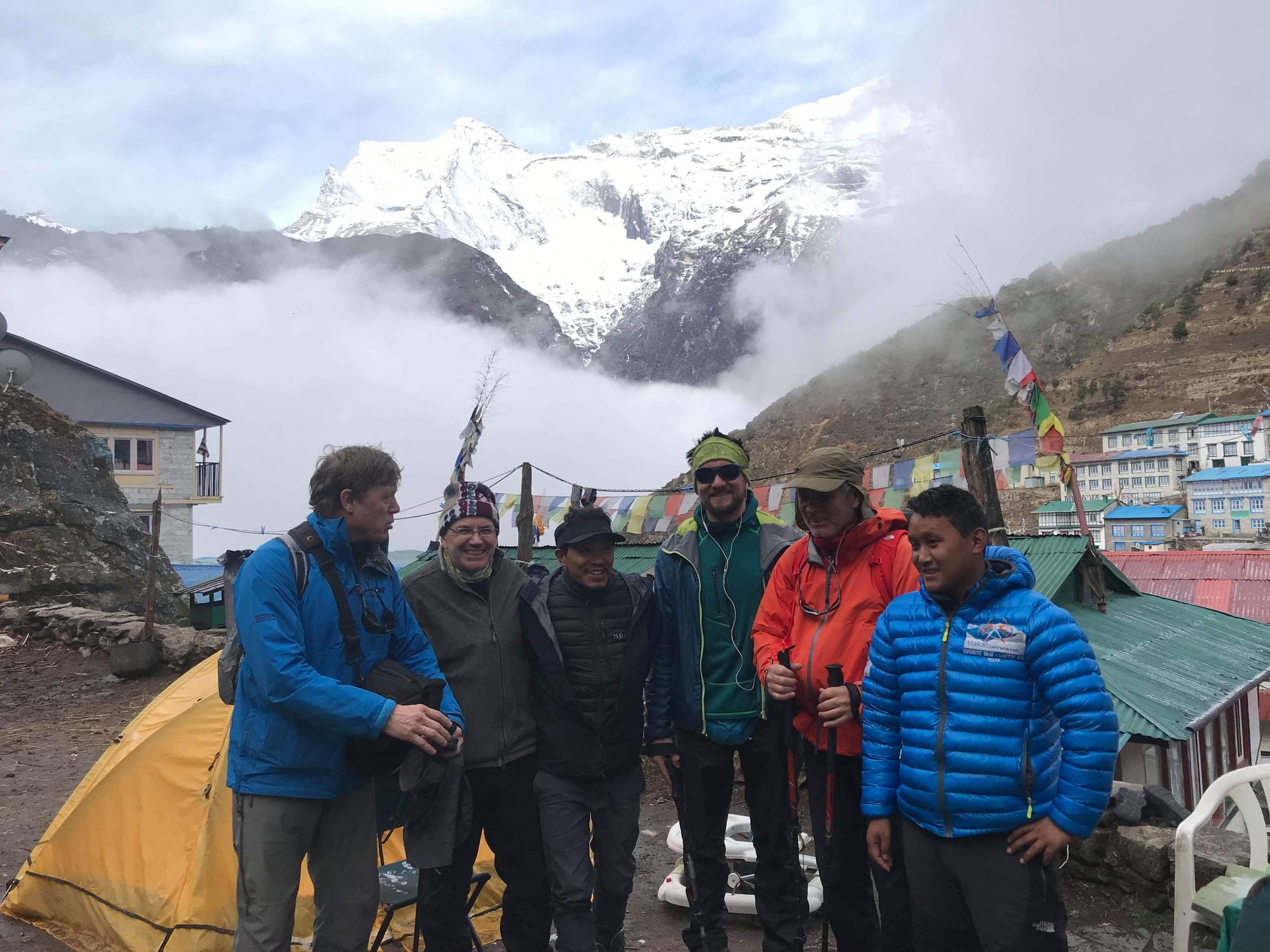
The village is very famous for tourists and climbers, because it is located on the road to Everest and has an expanded system of tourist hotels, restaurants, shops where tourists can relax and prepare for the hike. There is electricity in the village, and the Syangboche airport (helicopter station) is located nearby, but most tourists cannot use It: due to the protest of local residents, Lukla airport (located about 13 km South of Namche) is used for mass tourism. From the airport to Namche Bazaar, tourists must make a daily transition (in the case of a very fast walk, six hours is enough). Servicing tourists on this site provides employment and income to local residents.
Namche Bazar is also home to official institutions, police control, a post office, and a Bank. The Nepalese army barracks are located at the top.
Namche-Bazar is the main point for traveling to Everest, to the mountain and lake Gokyo.
Above the village is the base of the Sagarmatha National Park, which offers views of mount Everest and other mountain peaks.
At an altitude of 3800 above Namche Bazar, the Everest view hotel is a luxury hotel with a terrace where you can see mount Everest in good weather. The hotel organized trips for rich tourists, but many experienced acute mountain sickness from the sudden ascent to such a height. The hotel is additionally equipped with a dome and oxygen supply of rooms.
On Saturdays, the market opens in the morning, which attracts residents of the surrounding villages, as well as Tibetans who come with goods through the passes from Tibet with Chinese goods

There are several Tibetan monasteries in the vicinity of Namche Bazar.
In the late 1980s and early 1990s, a small hydroelectric power station "Thame-Namche Bazar" with a capacity of 620 kW (two 310 kW bucket turbines each) was built with the financial assistance of Austria to electrify the village and nearby settlements of Khunde, Kumjung, and Thamo)
The village is located at an altitude of 3440 m on a side slope of a hill.
According to the 1991 census the village had 1647 inhabitants in 397 households
To the West of Namche Bazar is mount Kongde-Ri with a height of 6187 m, and to the East is mount Thamserku with a height of 6623 m.
The first day in the village we will make a trekking tour around the village. On the second day, we will go to the village of Syangboche and to the view point. We spend the second night in the same way, in Namche Bazaar.
The next day we go further, towards the Base Camp. Overnight in the village Deboche. From the pass Syangboche first time, views of Lhotse and Everest. From here, we see our goal in full view for the first time. It is a 6-hour walk from Namche Bazar to Diboche. The path first goes down to the river, and then rises again to the hill where the monastery of tiangboche is located. The altitude here is 3900 m. We visit the monastery and get the blessing of the monks to ascend. You can bed down in the village Deboche. We spend the night in a beautiful place, a loggia called Ama Dablam Lodge. This is one of the oldest and most comfortable loggias in the area with its own traditions.
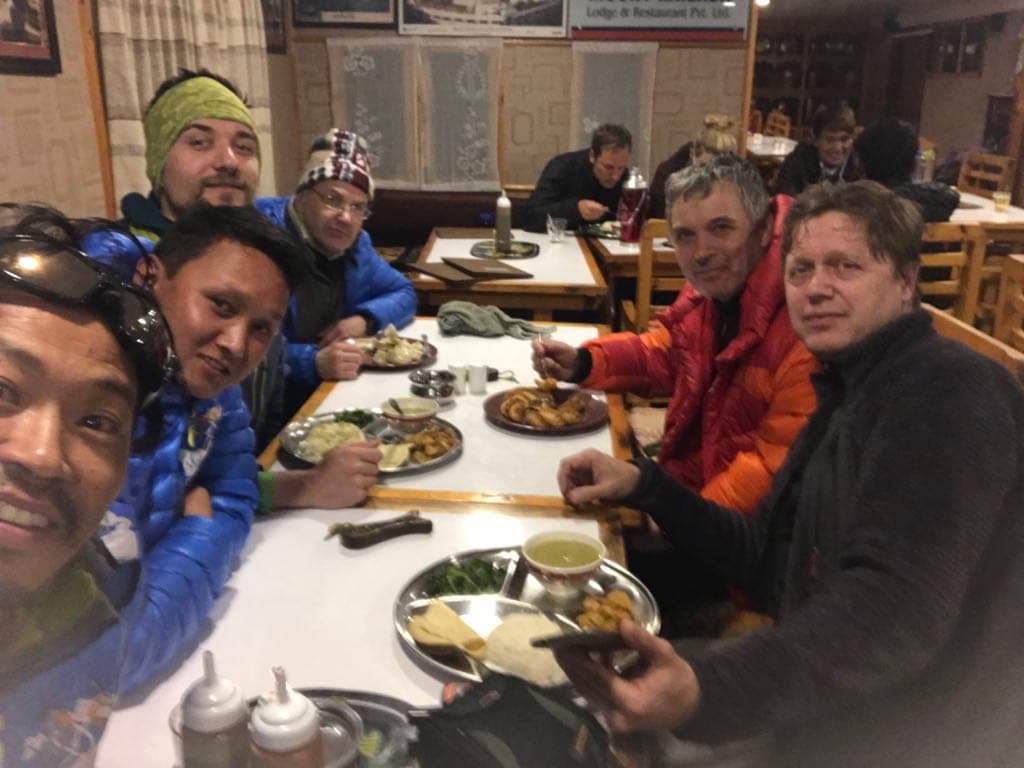
The next day brings us to the village of Dingboche. It's not a very long day with a very gentle climb. The village is located at an altitude of 4300. Here we will spend another night for acclimatization. For acclimatization, we go up to the observation point 5400 the next morning, and then return to the hotel again.
And so, we are only two days away from Base Camp.
We leave not very early, having had a good night's sleep. It's not far to go today. We have to climb to the village of Lobuche at an altitude of 4600 meters. We check in at Oxygen Hotel. This is a very comfortable hotel for these conditions. The dining room is very hot and heated, even when it's freezing outside.
The next day, transfer from Lobuche to the Base Camp. This is an early exit, since the entire journey will take about 6 hours. Our base Camp is located deep in the Khumbu glatchier, just before the beginning of the ropes that lead to the Khumbu icefall. Upon arrival at the Base Camp, we are already waiting for a wonderful lunch and a warm dining tent. Our dining tent is heated by a gas heater, so it is much warmer than outside.
What do our participants carry in their backpack during the day?
Our participants carry a bottle of water or thermos of tea, sunscreen, spare gloves, Windproof jacket, down jacket. All other things are transported by yaks in our caravan. The baggage allowance that a participant can give to the caravan is 30 kg per person for full service participants and 60 kg of cargo for VIP service participants.

I would like to draw Your attention to the fact that on the way to the base camp, all our food will be prepared by our expedition cook. We eat Breakfast in the morning. Fried sausages are usually served for Breakfast,
fried or boiled eggs, sliced cheese, porridge or rice pudding. Drinks include green tea, black tea, herbal tea, or coffee.
For lunch-soup or borsch, buckwheat porridge, macaroni, potatoes, wheat porridge, fried chicken, chicken with mushrooms, cutlets, steak, fish, pasta, pizza, salads from fresh vegetables, vegetable stew and ajap sandal. Drinks include black, green or herbal tea, hot chocolate, cereal hot drinks, cookies, chocolate, coffee
On days when we have to go a long day, the cook gives participants and guides a pack lunch. There you can usually see a fried pie, boiled eggs, cheese and sausage-sliced.
For dinner, there is about the same set of dishes as for lunch. Also on birthdays, days of reaching the Top and national holidays, our chef will bake us a cake with cream.
Meals and accommodation throughout the route are included in the tour price.
Alcohol is not included in the price, so if you plan to use it, then you need to take additional funds.
The entire group is accompanied by our mountain guides and us, the tour organizers, on the way to the Base Camp.

Base Camp will be our home for the next month. Now I will tell You about how life is arranged in our Base Camp. Social life is concentrated in the dining tent, which is also the mess hall. This is a very spacious tent, the floor of which is covered with carpet. It is also equipped with a gas heater. Therefore, it is always warm. Even in the coldest weather. Usually this is where all the parties, drinking hot tea, talking, playing cards or checkers, watching movies on the laptop.
To stay in the Base Camp, each participant receives an individual tent V-25. If the participants arrived as a couple, they can check in together. For VIP service participants, we have special tents for accommodation. These are large, stationary tents where you can stand at full height, measuring 2.5 x 4M. The tent has an entrance hall, and the floor is covered with carpet. All tents without exception are equipped with sleeping mattresses.
Also in the Base Camp there is a tent, which is called a baggage tent. You can put all the extra stuff in there.
Our shower room consists of two rooms. In the first room, you can change your clothes, leave dry things and towels. The second room is a shower room.
In the morning, there is always hot water in the washbasin for washing. Meals at the Base Camp are 3 times a day - Breakfast, lunch and dinner. Just always in the dining room on the table are thermos flasks with hot water, tea, coffee, chocolate, cookies. Participants can come there for tea at any time.

Upon arrival at the Base Camp, we will stay here for 4 days. During these days, we will make acclimatization rotation and return to the Base Camp for the night. We will go up to the middle of the Khumbu icefall and climb Kala Patar 2 times. On one of these days, a Puja will be held. Puja - a worship service for a successful ascent. At the same time, the camp is consecrated. No expedition is sent up until this rite is performed. Puja takes about 3 hours. During the monk's prayer, the guides stretch a network of prayer flags over the Base Camp. According to ancient tradition, flags should calm the elements, and thus ensure a safe ascent and descent for climbers.
On the fifth day of our stay at the Base Camp, the first acclimatization rotation will be planned.
Now I want to tell you what our participants carry in their rucksacks during high-altitude rotation and during the summit push. Most things, tents, food, high-altitude gas, oxygen, sleeping bags, all this is entered by high-altitude guides. They also set up high-altitude camps. Participants carry their personal belongings, sun cream, thermos of water, a down jacket, and a windproof jacket. A personal guide will be attached to each participant for high-altitude exits. Participants of the VIP service will have two personal guides, and therefore they do not carry anything in their backpack. Guides take care of the safe passage of the route, prepare food for participants in high-altitude camps, and help on runs at high altitudes. VIP service participants do not need to fasten themselves at all - guides will do everything for them.

During this rotation, we will have to cross the Khumbu icefall and climb to Camp 1, and then the next day to Camp 2. The next day we will go up about 300-400 meters in height in the direction of Camp 3 and go down to spend the night in Camp 2. The next day we go down to the Base Camp. Walking on an icefall is a very exhausting story. Therefore, we will need at least three days to recover from the high-altitude exit. And then we are again waiting for the acclimatization round. Again we cross the Khumbu icefall, go up to Camp 1, the next day to Camp 2, the next day to Camp 3. We spend the night in camp 3. In the morning we go down to Camp 2, the next morning to the Base Camp. Now we need to recuperate, and we are ready for the assault. Now we will choose the appropriate weather window. The Base Camp has an Internet connection from the provider Everest Link, so we are constantly able to receive updates of the weather forecast.
Oxygen is another separate topic in the high-altitude expedition. According to our experience, we have included in the package the minimum number of cylinders required for safe ascent.

For a safe ascent, you need 4 oxygen cylinders. This is exactly the amount we have included in our commercial climbing package. The company will also give You a set of oxygen equipment for use. I want to remind you once again that 4 cylinders is the minimum amount of oxygen for a successful ascent. If you want to make your ascent more comfortable and safe, you can buy oxygen at your own expense. The cost of 1 cylinder of oxygen is 500 dollars. I would like to draw Your attention to the fact that the readings on the filling of the balloon in Kathmandu and at an altitude of 7000 and 8000m on the pressure gauge will differ greatly due to the huge difference in atmospheric pressure. If you plan to use 4 cylinders, then you can wear an oxygen mask no earlier than Camp 3 at an altitude of 7200 meters and you can only sleep when you feed 0.5. If you use more oxygen than you are supposed to, you will definitely not have enough oxygen to get to the Top and back. Therefore, in the oxygen issue, it is very important to assess your strength very soberly. We included 10 oxygen cylinders in the VIP package. Thus, VIP participants can use oxygen in the most comfortable mode. They can put on an oxygen mask already at the foot of the LHOTSE FACE wall and use oxygen on feed 1 during sleep. Also, during the assault, VIP participants will have enough oxygen to maintain a good climbing speed, which makes the summit push as safe as possible.
We leave for the summit push in the nearest weather window after acclimatization rotation. Each of our participants has a personal guide, and VIP service participants have as many as 2 personal guides. Therefore, each group of participants-guides will move in a convenient speed and mode for the participant. It is not necessary to wait for each other, especially since the participants of the full service and VIP service are initially in unequal physiological conditions in terms of the number of guides and oxygen.
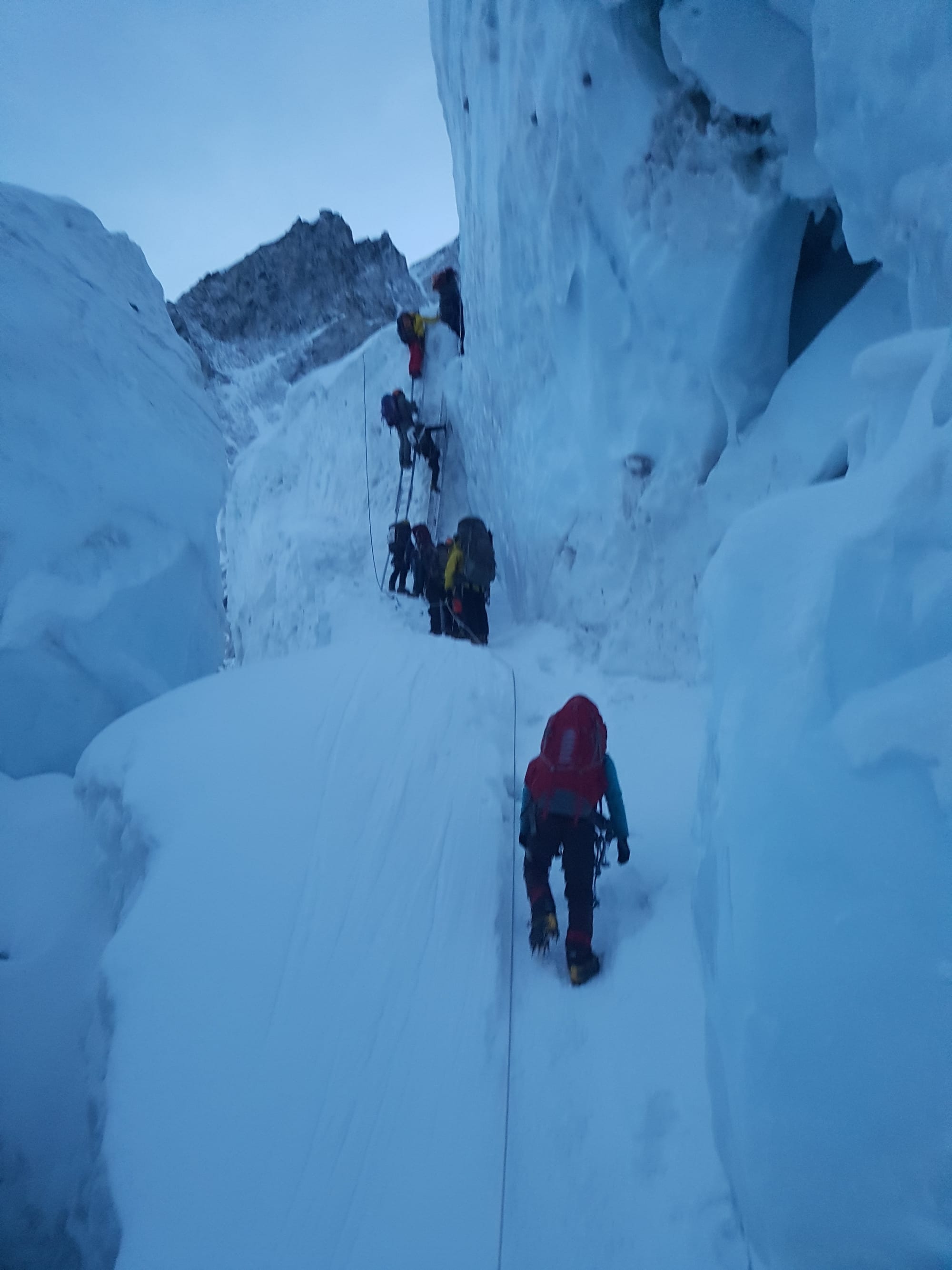
When participants rest between high-altitude rotation, their guides continue to work. They build and equip a network of high-altitude camps. Thus, when we go to the assault, the entire infrastructure of high-altitude camps is already ready. I want to write about Camp 4 separately at the beginning of the couloir. This camp is located at an altitude of 7800 on a very steep slope. To install it, our guides will need to first stuff snow anchors into the slope, lock them with a rope, and fix them with them a rope net. Then the guides will fill the garbage bags brought from Kathmandu with snow and fill the makeshift retaining wall made of snow anchors with these bags. Only then will they set up tents on the site obtained during construction work. According to the laws of the community on the Mountain, only the company that owns them has the right to use this site and tents on it in any situations. This is very true, since the construction of Camp 4 is really a very difficult and financially expensive operation. The work of a qualified guide at these heights is very expensive and all these payments fall on the shoulders of the organizer.
And so, we went on the summit push. Each rope team of the guide-participant moves at its own pace. The way from Base Camp to Camp 1 is usually no later than 12 am, as it is desirable to pass the collapse of a dangerous icefall at night. Further, the other outputs may be later. I also want to pay attention to the section Camp3-Camp 4. in the area of the yellow belt, the route can be very dangerous on a Sunny day, so, again, it is necessary to go out on this section early.
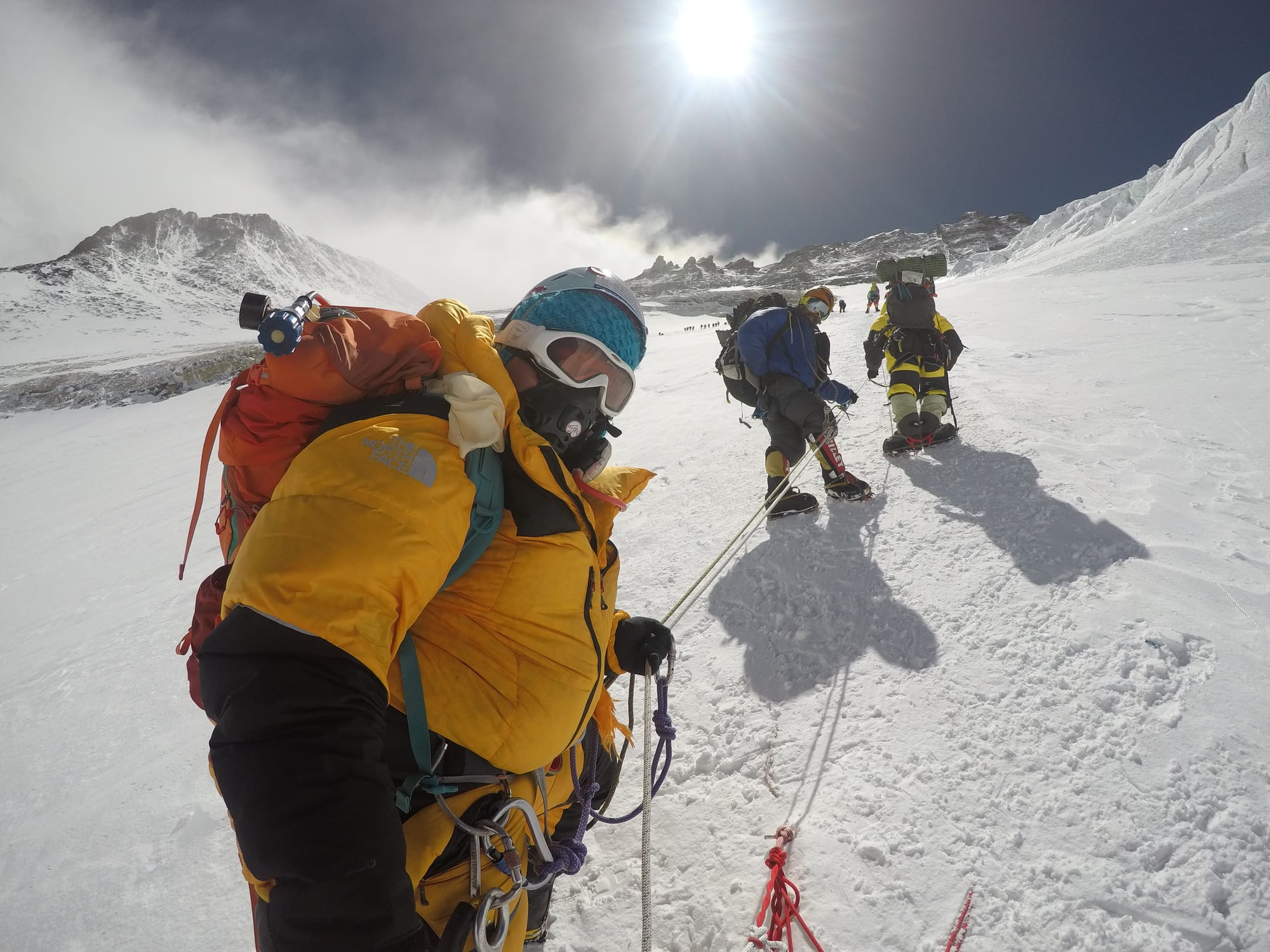
We leave Camp 4 for the summit push no later than 10 PM. During the summit push, the participants only have a thermos with hot tea in their backpack and one oxygen cylinder, from which the participant directly breathes. This is going to be a hard day. The couloir of the Genevese, which leads to the Top, is very steep. Because of the passage of this couloir, Lhotse is considered one of the most difficult Peaks of our Planet. From the camp, first, we traverse the steep firn fields to the right, and then we get into a steep, ice-rock couloir, which in places becomes very narrow, like a chimney. After expanding the couloir, we get to the foot of two steep rock walls, which lead to the top of the dome. On the way up, we can see the most incredible views in the Himalayas. Lhotse is the place where a Dream comes True, and, in a few hours, comes a Dream again.
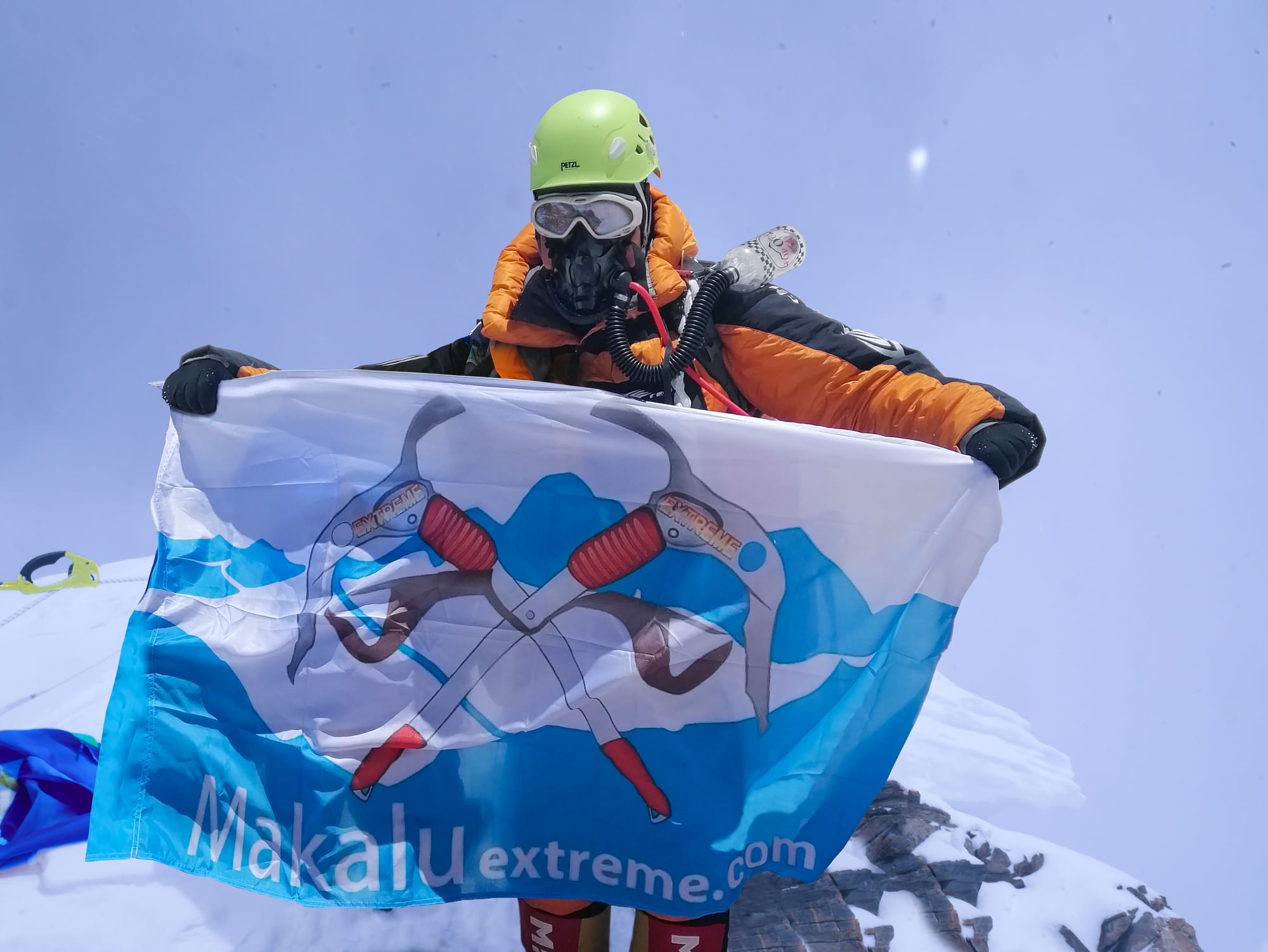

From the Top we go down to Camp 4 or 3, which everyone chooses according to the physical condition and amount of oxygen.
Next day - the descent in Camp 2, and the following day descend to base camp. At the Base Camp, we will have a celebration dinner, cake, and a hot shower. The next day we rest and pack cargo. And finally, the next day we leave the Base and go down. The descent takes place on the way up. We also stay in the same hotels as at the beginning of the expedition.
At Lukla airport, we say Goodbye to the Himalayas.
In Kathmandu, participants have another free day to buy Souvenirs, banquets and excursions.
The next morning, we escort the participants to the airport. We, the organizers, hope to see our participants in our next expeditions, because there are 14 eight-thousands on Earth!


